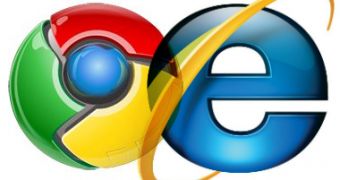There’s no way around it, Microsoft needs to make the next iteration of Internet Explorer, IE9, as fast as Google Chrome, if not even faster. As a general rule, Google Chrome evolves at a much faster pace compared to Internet Explorer, after all, the Mountain View-based search giant has gone through three major versions of its open source browser in a little over a year since v1.0 was initially introduced, and it is laboring to finalize v4.0. It's taken Microsoft since the end of 2006 to produce Internet Explorer 8 in March 2008, and in this regard, IE’s performance, features, capabilities will always suffer from a handicap compared to rival products, simply because of the pace at which the company delivers major versions of its browser.
The speed at which Google and Mozilla swap major versions of Chrome and Firefox will undoubtedly contribute to the generalized perception that Microsoft is constantly playing catch-up with IE, rather than driving innovation. Fact is that with IE8, the Redmond company focused very little on driving JavaScript performance for the browser. The software giant had its reasons, supported by the argument that JS is only one aspect of a browser’s performance, in some scenarios down right insignificant, and by proof that IE was loading pages on par with Chrome and Firefox.
However, since the advent of IE8 Microsoft has apparently understood that user perception of browser speed is critically as important as the actual level of performance, albeit only one of the two is measurable, while the tests themselves are far from reflecting real-world scenarios users come across. At PDC 2009 last month, Microsoft demonstrated an early preview version of Internet Explorer 9, indicating that it almost matched Firefox 3.6, and was just two times as slow as Chrome 4.0 in the SunSpider test, from Apple’s Webkit team.
Microsoft notes that IE9 finished the SunSpider test in 986 ms, while Firefox 3.6 did it in 840 ms, and Chrome 4.0 went through up the test in 437 ms. It is clear that Microsoft needs to be aiming for the Chrome-level of performance when it comes down to the JavaScript engine. But at the same time, while taking in consideration that a few versions of Chrome will be offered across a single year, IE9 needs to outrun Google’s open source browser.
Min Li Chan, Google Chrome product marketing manager, published a series of videos designed to explain just what makes Chrome as fast as it is. Obviously, Chrome’s recipe for JavaScript performance is not limited to a single ingredient. The videos in question, embedded below, discuss DNS pre-resolution, the V8 JavaScript engine, and DOM bindings. At PDC 2009, Microsoft made public the first details about the next generation JavaScript engine in Internet Explorer 9 (the fourth video embedded below).
Internet Explorer 8 is available for download here.
Opera 10.20 Alpha is available for download here.
Firefox 3.6 Beta 4 for Windows is available for download here.
Firefox 3.6 Beta 4 for Mac OS X is available for download here.
Firefox 3.6 Beta 4 for Linux is available for download here.
The latest releases of Google Chrome are available for download here.

 14 DAY TRIAL //
14 DAY TRIAL //